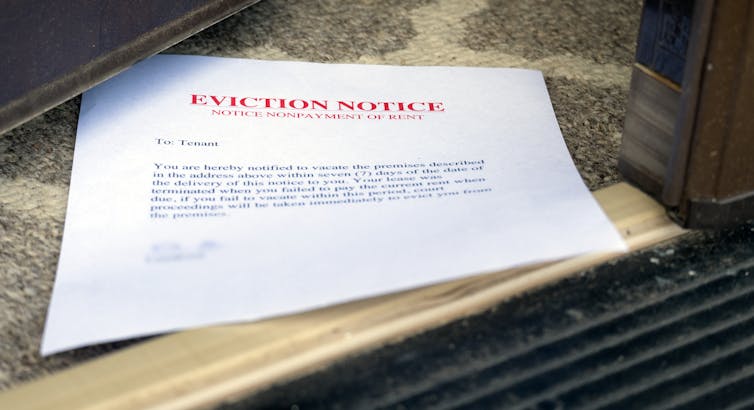
Tom Simcock, Edge Hill University
The controversial roll out of Universal Credit has been stalled. Under pressure from across the political spectrum, work and pensions secretary Amber Rudd has unveiled a “fresh approach”. Among the new measures, Rudd has announced that the government will launch a digital platform, which promises to streamline housing benefit payments to landlords, in cases where the tenant is having difficulty paying rent.
Though it sounds technical, there is much at stake: landlords wait much longer to receive such payments from the government under Universal Credit than they did under the previous system, which was administered by local authorities. And while they wait, tenants can slide further into arrears, leaving them prone to eviction – and possibly, homelessness.
If successful, the platform could benefit landlords, as well as tenants facing the prospect of eviction when they fall into rent arrears. Yet evidence suggests that the new platform cannot plaster over the deeper issues around housing affordability, which are causing benefits claimants to lose their homes.
Rising rent arrears
Research I conducted for the Residential Landlords Association showed that over the past three years, more and more landlords have reported tenants on Universal Credit going into rent arrears. In 2016, 27% of landlords said their tenants on Universal Credit had gone into arrears. By 2018, this had more than doubled to 61% of landlords.
Before Universal Credit, housing benefit could be paid directly to landlords without delay, at the discretion of local authorities. But now, landlords must wait until a tenant has been in arrears for two months before they can apply to receive the housing benefit directly from the government to cover unpaid rent.
On average, it takes 9.3 weeks for landlords to receive the first payment. By that time, the tenant could owe up to four months worth of rent. At this point, the tenant is at significant risk of losing their home, as landlords can lawfully evict tenants with two months of rent arrears. This was borne out in our research: 77% of landlords in my study reported that the main reason for evicting tenants on Universal Credit was unpaid rent.
If the government’s new platform makes it quicker for landlords to receive a direct payment, it could reduce rent arrears, help to sustain tenancies and ultimately reduce homelessness. But our research also showed that there was a significant increase in rent arrears for tenants who claimed housing benefit, but were not on Universal Credit. This tells us that the roll out of Universal Credit isn’t the only thing which is causing hardship for private tenants.
Five year freeze
These problems can be traced back to 2013, when the government reformed how the housing benefit is calculated. Previously, each claimaint’s entitlement was worked out using Local Housing Allowance (LHA) rates, based on private market rents in the claimant’s local area.
But from 2013, the government capped how much the LHA rate could rise – first in line with inflation, and then to 1% each year. In 2016, Chancellor George Osborne froze LHA rates for four years. In effect, this means that the housing benefit has not kept up with rising rents for five years.
Recent research from Manchester Metropolitan University found that the LHA rates were a major factor in the increase in homelessness. Researchers found that tenants on benefits were more likely to lose their tenancy, and then have difficulties finding an affordable home to rent, due to the gap between housing benefit and the rent.

Analysis by the Chartered Institute of Housing (CIH) has found that 90% of LHA rates across the country did not cover the cheapest rents and that some families face a shortfall of hundreds of pounds a month.
This is extremely worrying, especially as the latest figures from the government show that there are 1.2m housing benefit claimants in the private rented sector. And statistics from the latest English Housing Survey show that 81% of claimants report that their benefits only cover part of their rent.
This means that nearly 1m low-income renters are now struggling with housing affordability, and being forced to make hard decisions about how they make up the shortfall created by the government’s housing benefit freeze.
Relieving the pressure
The “fresh approach” to Universal Credit may go some way to relieve pressure on households, by making it easier for landlords to claim rent directly from the government. But it will not address the underlying affordability issues caused by the benefit freeze.
Rudd has said that the benefit freeze should not continue past 2020 – but serious questions remain. For example, if the freeze is lifted, will the LHA rates be increased to current market rent levels? The CIH estimates that this would cost the government nearly £1.2 billion in housing benefit payments, placing further pressure on the Treasury.
Building more social housing – with rents linked to tenants’ income, rather than rising property and land values – would directly address the lack of affordable housing for society’s most vulnerable. A cross-party report from housing charity Shelter recently called for the government to build 3.1m new social homes by 2040 to this end, costing £214bn over 20 years.
One thing is certainly clear: without action to improve housing affordability and end the benefit freeze, the hardship faced by renting families, those just about managing, is likely to get worse.![]()
Tom Simcock, Research Fellow, Edge Hill University
This article is republished from The Conversation under a Creative Commons license. Read the original article.
